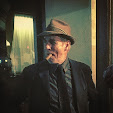Clowns being subtle.
On a recent day off from the circus I found myself driving down one of the familiar streets of my hometown of Santa Monica and noticed a group of iaidoka practicing Japanese swordsmanship in a small fluorescent lit dojo on Pico Boulevard. I pulled an immediate U-turn and went inside. After speaking briefly with the Sensei, (Michele Benzamin-Miki Sensei) I was treated to a spirited session of Aiki Toho Iaido and bokken (wooden sword) training.
En Prise
Miki Sensei was demonstrating a technique or what the Japanese call a Waza, in which you remain poised after your downward cut to the opponents’ neck until he indicates submission. This signal of submission is like what they call En Prise in chess. The opponent says “Alright, you got me. Game over.” with his body.
Practitioners are encouraged to feel the submission and not rely on outward indications such as the lowering of his sword. (Which may indeed be a false “Tell” that actually gives the seemingly defeated opponent more room to remount an attack.)
After class I asked if there would be any classes offered on Monday nights to fit my schedule. With very little coaxing I revealed I was on tour with Kooza.
At the sound of the word, one of the practitioners, a Brazilian with a thick accent and a well-worn hakama lit up.
“Kooza! Incredible! The most amazing experience! Me, I love it!. What do you do for Kooza?”
“I’m one of the clowns. I play the King.” I reply.
His face goes blank.
“King? Clowns?”
He looks at me hard, trying to place me in the swirl of his memories of the show. I stroke my beard to give him a hint. There is a silence as he peers at me skeptically. Then the light bulb goes on over his head.
“Of course! You’re one of those guys that was running around everyplace doing anything you wanted! Yes, I remember now.”
And that’s when I realized the vital importance of secret smiles.
Of course we aren't running around doing anything we want. Kooza is a tightly calibrated machine and our clown acts, though fairly loose in structure are honed by trial and error and hundreds of repetitions. This does not preclude letting the audience in on the process with little flashes of sincere, unscripted delight.
In poker they call them “Tells.” Tiny flickers of the inner state that surface briefly to reveal the turmoil or entrancement that live underneath the mask of the performer.
The Technique of the Tell
These Tells say “Whoa. I wasn’t ready for that- but I’m delighted it happened." When used correctly they can give the illusion of joyful spontaneity and that’s why a Brazilian martial artist can watch us clowns and think “These guys are doing anything they want to!”
So the technique of the “Tell’ in clowning must be attached to the heart, supported with sincerity and as indelible as a subliminal flash of pure joy. Otherwise the attention of the audience, like the swordsman holding his blade to the throat of his opponent, will remain poised like Damocles. These tiny glimpses of the inner state reveal that yes, there is a person under all that make up and he is having a ball.
They can be as momentary as a blink and yet speak volumes. Using them in the clown act is one of the techniques we rely on in convincing the audience that the true spirit of playful anarchy is alive in the room. These “secret” or to use the Japanese word Himitsu smiles tell the observer that the unexpected has happened, that the performer is secretly tickled, amused, surprised by what is happening- not as the character, but as himself.
Just another technique.
Keep it a secret.
Me and my boss, entrepreneur/spaceman Guy.





1 comment:
I love this post the details of the smallest nature can have the biggest impact. I also watched Guy in space how amazing too. Have a wonderful tour break a red nose or whatever they say to the clowns :)
Post a Comment